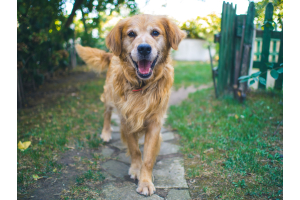To Treat or Not To Treat Tapeworms in Dogs

Ian Wright is an expert in this subject, as well as being a veterinary surgeon and co-owner of a practice in Fleetwood; he also hold's a Master's degree in Parasitology. He is head of the ESOCAP UK & Ireland, Guideline Director for ESOCAP Europe and editorial board member for the Companion Animal and Vet CPD Journals. This article reflects his views on treating tapeworms in the general canine population and the role of the veterinary practice.
Tapeworms - The Parasite in Our Homes
It is no secret as a nation (where the dog is the most popular pet owned) that we are devoted to our four-legged friends, and it is also no secret that perhaps because they share our households; many owners simply forget that they can act as hosts to unwelcome parasites such as tapeworms. The main tapeworm that the average pet owner will come across is Dipylidium Canium.
Dipylidium Canium
This is the most common tapeworm to infect our pets in the UK but what many pet owners still don’t know is that this parasite is spread by the humble flea. Although tapeworms are not aesthetically pleasing; their occurrence inside our pets actually only has limited negative effects.
The Life Cycle of Infestation
Tapeworms live in the intestines attached to the intestinal wall. Eggs or proglottid segments containing eggs are passed into the faeces and ingested by the intermediate host leading to cyst formations in bodily tissues. It is these cysts that are infected when ingested with the exact life cycle depending on the tapeworm species.
Taenia SPP
Large adult tapeworms measure up to 500cm in length, and infected cysts are ingested by dogs through eating afflicted rodents, rodents and ruminants. The risk to dogs is low if they do not scavenge and eat only processed commercial diets. However, the segments of Taenia spp (parts of the tapeworm that have broken off the main body) can sometimes be seen in the faeces of dogs whose lifestyle habits and/or diets put them at risk.
Echinococcus Granulosus
The lifecycle of this tapeworm begins with canids harbouring small adult tapeworms up to 6mm in length. Humans, ruminants and pigs act as the intermediate hosts where hydatic cysts are involved. This can lead to serious disease in humans with cysts forming in bone, liver, lungs, heart and central nervous system and have severe repercussions for the farming industry where any affected sock are condemned by the meat industry resulting in financial loss and hardship. The risk to dogs is low unless they have access to fallen stock or are fed raw diets.
Dipylidium Canium
The adult tapeworm is small with fleas and lice acting as the intermediate hosts. It is not difficult to see therefore how infestation occurs by ingesting these hosts on prey or while grooming their own coats. Good flea control is paramount to controlling this tapeworm.
Hydatid Disease and the Food Standards Agency
Canine Taenia spp are found throughout UK farmland and surprisingly cause little in the way of negative health effects when they form hydatic cysts in their intermediate hosts which consist of lagomorph and livestock.
The main effect is not the health of the host but economic in terms of infestation rendering stock useless for the meat industry. The food standards agency (FSA) indicated that 548000 ovine lives were condemned for cysts in 2015 at a loss of nearly half a million pounds and 66,500 lamb carcasses rejected in 2012 for the same reason at a cost of 5 million pounds.
Praziquantel treatment
Praziquantel was used in a controlled dosing program in Wales in the 1980s was successful in reducing infestation in dogs and ruminants. Wales has been one of the most heavily affected areas for the presence of Hydatid disease as well as the Welsh Border, Herefordshire and Western Isles of Scotland.
Health Education
However; The Welsh Assembly has run a health education program since 1990 and promotes the use of wormer praziquantel to treat dogs, and although the prevalence of hydatid disease is now low, the incidence throughout the UK of E granulosus is much higher than previously thought. Work carried out in conjunction by the FSA, and Welsh government revealed E Granulosus to be particularly high on the Welsh Border and West Midlands with positive cases revealed in abattoirs. The knock on effect to canine infestation is obvious for those who are fed raw diets, those who work on farms, in kennels and hunts who are regularly fed offal or have access to fallen stock.
Preventative treatment for dogs
It is these high-risk dogs where preventative treatment is required to keep down the incidence of E granulosus and Canine Taenia spp as well as reducing the overall economic impact of hydatid disease. This has a three-pronged approach:-
- Regular tapeworm treatment of high-risk dogs
Those dogs that are fed on a raw diet, fed offal or have access to fallen stock should be wormed every 4-6 weeks with praziquantel. Dogs that are not considered to fall within these parameters and wormed every 3 months have shown to reduce infestations of E granulosus over time. However, it is not clear how much of an effect worming only 4 times a year has on the rates of condemnation of meat and offal. So, the most effective method is to worm monthly to prevent any shed to ruminants especially dogs at high risk of exposure and/or those who have a history of passing tapeworm segments in their faeces.
- Preventing dogs being able to access offal and ruminant carcasses
In order to reduce infestation, it is essential to educate dog owners regarding the lifecycle of the tapeworm and keep them on lead on livestock pasture. As will discouraging the feeding of offal or raw meat. If a raw diet wishes to be fed by the dog owner then feeding a raw but processed diet where any offal and meat has been inspected and frozen will help to reduce tapeworm infestation and risk to livestock.
- Campaigning against dog fouling
It is always said that education begins at home and so it is with the general public. Veterinary practices as well as displaying tapeworm and worming information in their reception areas can offer leaflets for their clients to take away and read at their leisure. This information can then be spread outward throughout the wider community by getting involved with local schools and helping to promote anti-fouling campaigns etc. as well as offering information through social media channels.
The dog tapeworm
Diplylidium Canium is what we term as the common dog tapeworm, and it is found infesting pets throughout the UK. With its life cycle linking primarily to fleas; infestations are most common when flea control programs are not in place or break down.
Human Host
Infestation in humans occurs after accidental ingestion of flea parts and so such hygiene practices as hand washing, changing bed covers often if they allow their pet to sleep with them, are important to keep risks low. Treatment with Praziquantel is found to be effective against an infestation, but effective flea control in dogs will control the risk of infestation in dogs themselves.
Zoonotic
D Canium is a zoonotic in that it can go on to affect humans as is the case of E granulosus, but in D Canium humans act as the definitive host with adult worms found in the intestines. Infestation is rare but when it happens; although rarely serious – it can cause discomfort and distress – perhaps more emotionally than physically.
The risk of Echinococcus multilocularis and travelling dogs
Infestation by this tapeworm presents a serious health risk with heavy infestations leading to hepatopathy and multiple organ involvement causing reduced life expectancy. This zoonosis is scary stuff, but please be assured that this tapeworm is NOT currently found in the UK. Its life cycle, however, does involve foxes and voles in other European countries and if it were to land on our shores, it would be difficult to halt an endemic due to it spreading through these populations of animals here. With the main risk to the UK being posed by travelling dogs – it is important to:-
- Educate owners travelling to Europe regarding the importance of compulsory tapeworm treatment before reentry to the UK
Some people natural rebel against what they see as "red tape". It is crucial therefore to emphasise the serious health risk posed to owners and also the implications of entry of such a serious zoonotic disease to the wider population.
- Advise treatment with praziquantel every 30 days while overseas
- Advise one follow up treatment within 30 days on return home
Conclusion
It has been shown that although tapeworm infestation has minimal effects on a dog as its host, humans and stock can be seriously affected in terms of health and economics. Dogs at high risk, therefore, require worming treatment at 30-day intervals in order to reduce the incidence of tapeworm infestation.








